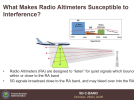Angara AN24 near Nizhnevartovsk on Jul 11th 2011, water landing after engine fire
The Interstate Aviation Committee (MAK) released their final report in Russian concluding the probable causes of the accident were:
The catastrophe of the AN-24 RA-47302 occurred when ditching became necessary due to a fire in the left hand engine's nacelle. The destruction of the aircraft and loss of life was caused by collision with underwater obstacles that the crew could not anticipate or avoid.
The fire in the left hand engine nacelle was caused by the fracture of a centrifugal breather releasing an air-fuel emulsion into the engine compartment as well as a delayed reaction to shut the engine down by the crew following an magnetic chip detector indication together with indications of oil pressure fluctuations, a burning smell and a low oil pressure indication.
A delay in indicating engine vibrations to the crew as result of degradation of the engine vibration sensoring equipment, most likely caused by changes of the rotor speed of the engine as result of the aft bearing failure of the compressor rotor and/or misalignment of the sensor, which probably influenced the decision of the crew to shut the engine down with a delay.
Cause of the fracture of the centrifugal breather was the destruction of the impeller due to prolonged exposure to hot air-fuel emulsion due to the failure of the aft compressor rotor support bearing.
It was not possible to determine the cause of the destruction of the aft compressor rotor support bearing due to significant secondary damage. Most likely the destruction was caused by misalignment such as:
- incorrect assembly of support parts mating with the compressor rotor during on-condition engine repairs
- or deviations from required geometry of support parts mating with the compressor rotor.
Contributing factors were
- psychological unpreparedness of the captain to shut the engine down due to lack of experience with the aircraft on one engine inoperative
- late detection of the fire and as a consequence late attempts to extinguish the fire, it was however not possible to establish why the fire was detected late due to lack of objective information about the performance of the fire alarm systems.
The MAK reported that the aircraft was enroute at 6000 meters (FL197) about 86 minutes into the flight when the flight engineer (47, FEL, 9,197 hours total, 9,197 hours on type) received indication of chips in the magnetic chip detector of the left hand engine. The captain (48, ATPL, 4,570 hours total, 4,064 hours on type), pilot flying, instructed the flight engineer to perform heightened monitoring of the left hand engine but decided to continue the flight. The aircraft was handed off to Nizhnevartovsk area control about 4 minutes later with the first officer (53, ATPL, 9,476 hours total, 5,100 hours on type) communicating with ATC as pilot monitoring. About another 4 minutes later the captain detected a burning smell in the cockpit, the crew decided as result to reduce power on the left hand engine, close the bleed valve on the left hand engine and divert to Nizhnevartovsk. The left hand engine fire indication activated over a period of 1.6 seconds. The aircraft was handed off to Nizhnevartovsk approach, the controller inquired for the reason for the diversion and the crew reported they had chips detected for the left hand engine, fire indication for the left hand engine and drop of engine oil pressure left hand engine. The aircraft was cleared to descend to 4800 meters for the approach to Nizhnevartovsk.
40 seconds later the flight engineer reported the oil pressure had been dropping rapidly and asked whether he should shut the engine down, the captain declined. Another 20 seconds, upon inquiry by approach control whether they would declare Mayday, the crew declared Mayday. The aircraft reached 4800 meters, the crew requested further descent and was cleared to 1800 meters. The crew performed an approach briefing which concluded about 80km short of Nizhnevartovsk.
16 minutes after the magnetic chip detector indication, the aircraft was descending through 3600 meters about 77km from Nizhnevartovsk, the captain announced dangerous vibrations from the left hand engine, left hand engine on fire. The crew shut the engine down. After visually confirming that the left hand engine was on fire the captain instructed the fire extinguisher being discharged into the engine, however all actions to extinguish the fire were unsuccessful. The captain radioed ATC reporting the left hand engine was on fire and they would ditch the aircraft right where they were.
The aircraft descended for a water landing, just before touch down after the location for touch down was chosen and immediately before touchdown the right hand engine was shut down too, the aircraft touched down on Ob River about 17.8km from Streshevoy Airport. As result of impact forces 7 passengers were killed, 10 passengers received serious injuries, one crew and 8 passengers received minor injuries, 3 crew and 8 passengers remained unhurt.
The cockpit section remained virtually undamaged, the fuselage encountered substantial longitudinal and transverse forces causing deformation of the fuselage especially the front section, mounting rails holding the seats suffered deformation and sprung up separating the seat belts from the seats, the center section of the fuselage was flattened, the tail of the aircraft separated from the airframe. The aircraft landed with flaps and gear retracted, ailerons, elevators and rudder were undamaged, the left hand wing showed fire damage. The left hand engine showed substantial fire damage inside the nacelle. Hydraulic damage was caused by impact forces at splash down, there is no evidence of a flight control failure prior to impact with water.
The MAK reported that both flight data and cockpit voice recordings survived in good quality and were available for the investigation.
The MAK analysed that exactly at the time, when the captain smelled burning the left hand engine's oil pressure indication began to fluctuate by about 5kg/cm2 (total pressure 49kg/cm2), the curve similiar to a saw tooth. Such an oscillation was not unknown as result of a deteriorated sensor. At that time the captain decided to divert to Nizhnevartovsk, the first officer radioed the request to descend, the left hand engine was reduced to near idle thrust.
During flight preparation the crew had taken notice of Streshevoy Airport and considered the aerodrome as an alternate, however, now the crew decided to continue to Nizhnevartovsk, that became known to the crew during some training flights and where a representative of the airline was available. The situation as presently known to the crew also did not require the diversion to the nearest suitable airfield. The flight engineer recommended shut down of the engine and a diversion to Streshevoy in case the situation deteriorated. The captain responded they would continue to Nizhnevartovsk.
Descending through about 3600 meters, 77km from Nizhnevartovsk, the flight engineer received an engine vibration indication of about 6.5G (editorial note: no error, the report states 6.5G, 6.5 times the force of gravity), shortly followed by the oil pressure dropping to zero prompting the flight engineer to again ask whether to shut down the engine and captain ordering the shut down.
Just prior to touch down the right hand engine was shut down, the aircraft touched down on the water surface at 1.4G. The aircraft subsequently collided with irregularities of the river bed causing vertical accelerations from +3.5G to -1.5G.
The MAK analysed that the engine trouble began when turbine blades and nozzles became damaged with debris being carried downstream in the gas path, the debris eventually damaging the aft turbine roller bearing, the bolts of the connection of the turbine shaft and oil pipelines.
The MAK analysed that the fire lasted for a period of 20 minutes until splash down, the fire had not been observed by cabin crew or passengers however. In the eight minutes following the chip detector indication the ball bearing of the turbine was destroyed developing enormeous heat in excess of 900 degrees C sufficient to ignite the air-fuel emulsion. During those 8 minutes the outbreak of fire could have been prevented.
The MAK spent pages on the analysis of why the fire indication lasted only 1.6 seconds listing and dicussing various scenarios including the first officer acknowledging and silencing the alarm without assessment of the situation without a final conclusion as to why the fire indication stopped after 1.6 seconds, due to lack of evidence.
The MAK thus analyzed that the captain did not timely decide to shut the engine down, later failed to detect the fire and activate the fire suppression in time.
Flight path of the aircraft (Graphics: MAK):
http://avherald.com/h?article=43f853ce/0002














Komentarze